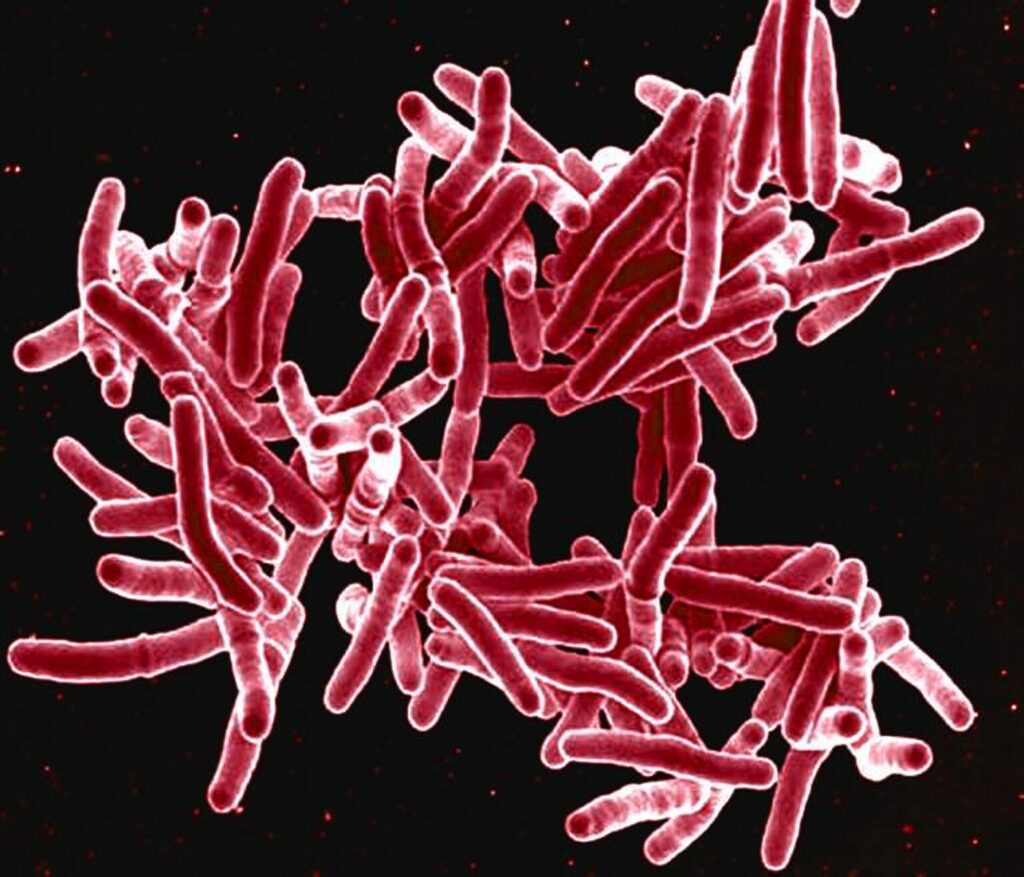U.S. tuberculosis cases rose 5% in 2022, disproportionately affecting communities of color.

BY: NADA HASSANEIN
Stateline
Until COVID-19, tuberculosis was the world’s deadliest infectious disease, killing about 1.5 million people annually.
Contrary to public perception, the disease is still active in the United States. The number of TB cases in the U.S. briefly dropped at the start of the pandemic, but there was a 5% increase in cases in 2022, according to the latest numbers from the federal Centers for Disease Control and Prevention, from 7,874 in 2021 to 8,300 in 2022.
Nationally, those numbers are still lower than they were before the pandemic, but some states — including Alaska, Nevada, South Carolina and Washington — have exceeded their pre-pandemic figures, according to a CDC report citing state data.
Even as the number of U.S. tuberculosis cases rises, public health experts say, awareness is lagging. And state and local health departments lack the resources to keep up with prevention and control efforts.
The disease spreads through the air when a person with an active infection coughs or sneezes. A bacterial infection, it usually attacks the lungs, but also can affect other parts of the body, including the kidneys, spine and brain. It’s usually treated via a four- to nine-month regimen of multiple antibiotics. A course of treatment for one tuberculosis case can cost around $20,000 in the U.S., and a drug-resistant tuberculosis case can cost at least $182,000.
People think tuberculosis is gone. … It’s here and growing.
– Dr. Georges Benjamin, executive director of the American Public Health Association
While anyone can catch tuberculosis, it disproportionately afflicts foreign-born people and Hispanic, Black, Asian American, Pacific Islander and Indigenous communities, according to the CDC. In total, the agency reports that about 88% of U.S. cases in 2021 were among racial and ethnic minority groups. That’s a product of structural barriers to health care and more crowded living conditions, experts say.
Black, Hispanic and Indigenous people also are more likely to be incarcerated, homeless or have HIV — all risk factors for the disease.
“People think tuberculosis is gone. … It’s here and growing,” said emergency medicine physician Dr. Georges Benjamin, executive director of the American Public Health Association, which represents public health professionals.
Benjamin said a lack of resources complicates state, local and federal efforts to control the spread.
From contact tracers to treatment coordinators, one patient with tuberculosis could require 10 to 15 staff members and clinicians tending to the case, according to Donna Hope Wegener, executive director of the National Tuberculosis Coalition of America, which represents tuberculosis program managers in states, cities and territories.
Since 1994, funding for the CDC’s Division of Tuberculosis Elimination has declined by about 60% when adjusted for inflation, according to a division analysis provided to Wegener.
An analysis by the Association of State and Territorial Health Officials noted that public health spending rose significantly in 2020 and 2021 in response to the COVID-19 pandemic, but the analysis also pointed to a sharp increase in vacancies in public health departments since 2016 and warned of a post-pandemic drop-off in funding.
A recent report by Trust for America’s Health, a nonprofit research and advocacy group, concluded that “many long-standing deficiencies remain unaddressed as state and local health departments could not use pandemic response funding to address other public health programming and infrastructure needs.”
“[Tuberculosis] programs are expected to do more with decreasing funding,” Wegener said. “I have heard several programs say to me that we are basically in a crisis mode right now.”
State and local efforts
In Alaska, which has the highest TB rate, the number of cases per 100,000 residents surged from 7.9 in 2021 to 13.0 in 2022. Hawaii has the second-highest rate, but its rate decreased slightly during the same period, from 7.4 to 7.0. California’s rate increased from 4.5 to 4.7, while the rate in both Texas and New York increased from 3.4 to 3.7 and 3.6, respectively, according to the CDC data.
In Texas, local health departments conduct their own investigations and follow-up, a spokesperson said.
Tommy Camden, tuberculosis prevention and control program manager of the San Antonio Metropolitan Health District, said the department runs a clinic and has partnerships with the local hospital and Texas Biomedical Research Institute. San Antonio is one of a handful of U.S. sites that received a 10-year research funding grant from the CDC.
But funding for prevention, treatment and control — including for public health staffing — falls short for San Antonio, Camden said. The city helped fund six more positions at the department to make up for the lack of state and federal dollars, he noted.
“It’s a huge challenge. … The state and federal grants have been capped,” he said. “As the needs and the necessities have increased, and the challenges have increased, the funding has remained pretty level and it’s put a strain on all the TB programs.”
In Alaska, advocates and medical professionals have been pushing for more state funding for TB control. Brian Lefferts, environmental health and engineering director of the Yukon-Kuskokwim Health Corporation, which represents 58 tribes, said the state contributed about $960,000 through a tuberculosis and congenital syphilis prevention grant.
“We still have a really large TB problem and so while that’s great, there’s always more that we could be doing,” Lefferts said.
In New York City alone, more than 530 TB cases were identified in 2022, according to the state health department.
When an outbreak occurs, the state health department coordinates with local health departments for contact tracing, screening and testing, Erin Clary, New York state health department public information officer, told Stateline. People who test positive for a TB infection are offered treatment, she said.
California health officials said they provide patient education materials in multiple languages and work with about 30 community-based organizations on outbreak prevention and coordinate with local health departments on responses when outbreaks occur.
Alaska’s community testing efforts focus on areas with the highest rates, including Alaska Native communities in the southwestern and northern regions of the state. In 2022, the state saw 95 cases, a 64% increase from the previous year, health department reports show.
Monitoring, screening to catch cases
There is a vaccine for tuberculosis, but it isn’t recommended for use in the U.S. because it can potentially interfere with tuberculosis tests via skin samples and has questionable effectiveness against pulmonary tuberculosis in adults. Research is underway for developing a new vaccine.
The disease can be difficult to treat due to antibiotic resistance — hence the multidrug regimen.
“Treatment gets very serious, because we have a lot of drug-resistant tuberculosis now,” said Dr. Allison Kelliher, a family medicine physician and researcher at the Johns Hopkins School of Nursing and the Bloomberg School of Public Health Center for Indigenous Health.
A person can have what’s called latent tuberculosis, an infection that isn’t contagious and doesn’t show symptoms, but can become active and contagious if the immune system fails to contain it.
“[TB] can be insidious. It can look different ways,” Kelliher said. She noted that along with pulmonary TB, there are other types that affect the bones or kidneys. “TB can be a great pretender.”
Kelliher, who is Koyukon Athabascan and from Nome, Alaska, knows the disease well: Her birth grandmother died from it, and her other grandmother, who adopted her mom, had a lung resection because of the disease, she said.
“The effects of TB are multigenerational and cannot be overstated as far as the disease and the way that it has devastated our populations in the past,” she said. “We tend to live in closer quarters.”
U.S. territories, including the Marshall Islands, the Northern Mariana Islands and Guam also see high rates: In 2021, each had 280.6, 67.8 and 34.4 cases per 100,000 people, respectively.
Chibo Ahrum Shinagawa, senior program manager of infectious diseases at the San Francisco-based Association of Asian Pacific Community Health Organizations, works on outreach and access to care in Pacific Islander communities on the mainland. She also manages the national TB Elimination Alliance.
Her group works with the CDC and community organizations on education efforts designed to “break down the stigma of TB and connect those most vulnerable, those with the most language barriers, those that need that culturally relevant and culturally linguistic care, back to the public health departments,” said Shinagawa.
An estimated 13 million people in the U.S. are living with latent tuberculosis, the CDC says, and many of them don’t know they have the disease. Experts say awareness around risk factors is imperative, so that people can get tested and prevent spread in case it becomes active.
As Congress considers cutting the CDC’s budget, Benjamin said he hopes to see resources preserved and allocated to the agency for tuberculosis control so it can better support states’ efforts.
“There really needs to be a statewide effort to address this,” said Benjamin. “There needs to be a greater emphasis on tuberculosis. Not that the CDC is not trying; they need the resources to do it.”
Our stories may be republished online or in print under Creative Commons license CC BY-NC-ND 4.0. We ask that you edit only for style or to shorten, provide proper attribution and link to our web site. AP and Getty images may not be republished. Please see our republishing guidelines for use of any other photos and graphics.


